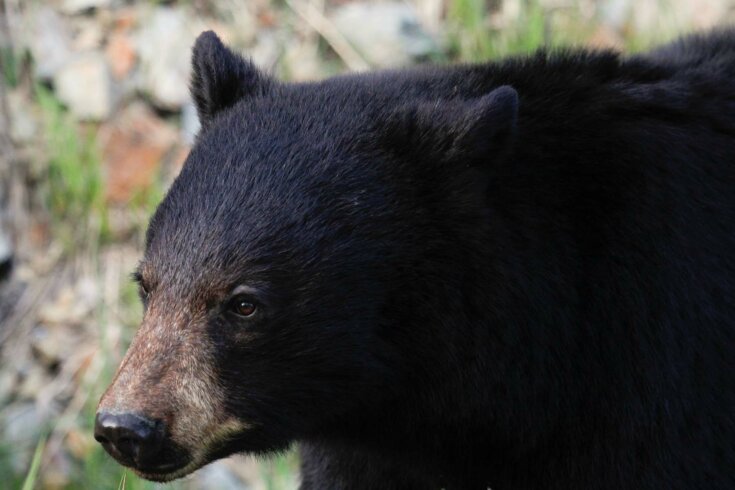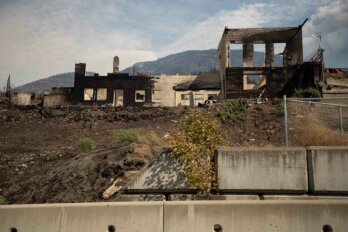In early May, two black bears roaming a rural residential subdivision in Whitehorse got into unlocked dumpsters and gorged on human trash. When the bears became aggressive, territorial conservation officers euthanized the animals. “This is a sad reminder that our actions directly impact the lives of our wild neighbours,” Yukon Conservation Officer Services posted on its Facebook page. “We can do better.”
Living in the Yukon means sharing space with bears. In Whitehorse, we carry bear spray when out on the trails, shout and sing as we hike, bike, and run through the woods to alert wildlife to our presence, and post about sightings of bears in the neighbourhood on Facebook so people give them space. The Yukon government urges residents to take down bird feeders, lock up waste, and put electric fencing around chicken coops and outdoor compost. Despite the annual reminders, every spring and summer, bears wander into the city, and every spring and summer, they are killed.
This delicate coexistence isn’t unique to Whitehorse; every municipality in bear country grapples with it. Human garbage and compost are a big draw for bears, and once a bear eats human food—often rich, smelly, and high calorie—they’ll go to great lengths for more of the same. Hazing a food-conditioned bear with rubber bullets, or relocating it, is often unsuccessful. Bears are experts at returning to good food sources. Last summer, a black bear was spotted munching on a berry bush in a residential Whitehorse yard. Conservation officers captured it and relocated it nearly 100 kilometres away. Fifty hours later, the bear was back, eating from the same berry bush. The real issue, though, is garbage.
Squamish, British Columbia, a town sandwiched between forested mountains, provides curbside compost and garbage bins that have two locks on the lid; residents must then unlock the container on the morning of curbside collection. More than two decades ago, Canmore, Alberta, located in the Rocky Mountains, eliminated curbside pickup entirely, in an attempt to reduce human–bear conflict. The municipality brought in communal wildlife-proof Haul-All dumpsters to which residents must transport their trash. The transition was prompted by a bad bear year—in 1998, four bears habituated to human food were euthanized in the Canmore area, and nine others were relocated. Both Squamish and Canmore have smaller populations than Whitehorse’s. In Coquitlam, BC, which borders Vancouver’s North Shore mountains, with more than four times as many residents as in the Yukon capital, the municipality retrofitted residential green bins with locks and collects compost weekly rather than biweekly. It also rolled out informative videos that encourage residents to be “bear smart” and employs an urban wildlife coordinator, who gives presentations at schools and summer camps and fields residents’ questions about coexistence.
These overhauls haven’t been without challenges. Changing human behaviour is difficult. According to a 2018 report by the nonprofit WildWise Yukon, communities in British Columbia, Alberta, and Alaska experienced low compliance and pushback when they introduced bear-resistant bins. Over time, though, when paired with education and outreach, buy-in grew.
The other main challenge is that bears are both intelligent and determined. Over time, they can figure out how to pry, crack, and bash open bear-resistant bins. The district of Squamish has tested different containers and locks and now also promotes keeping garbage behind closed doors, in a garage or basement, until the day of pickup. Coquitlam no longer enforces the use of its locks—they turned out to be that ineffective at keeping bears out. The municipality encourages residents to store their garbage and compost in a garage or a “wildlife-resistant enclosure,” like a heavy-duty shed or behind chain-link fencing, until collection day.
In Whitehorse, bear-resistant bins have been piloted, with poor results. Between 2013 and 2015, WildWise Yukon retrofitted 200 municipal garbage and compost bins with Rollins locks. WildWise saw decreasing compliance over the pilot’s two summers, with only 50 percent of residents using them at the last assessment. Participants complained that the weight of the lock led to cracked lids and broken hinges. The pilot ended, and Whitehorse’s curbside garbage and compost bins currently have no locking mechanism to keep wildlife out.
Stronger bylaws could help. That’s been key to progress in other communities, where bylaws about solid waste and wildlife attractants have been revised and are consistently enforced. Whitehorse’s waste management bylaw states that garbage shouldn’t be stored in a manner that attracts wildlife. As the bylaw doesn’t mandate bear-resistant locks or enclosures, it seems open to interpretation. It also sets out a window during which residents should bring their bins to the curb on the morning of collection, though I do not see this being enforced consistently. Plus, many Whitehorse homes don’t have garages, so people typically store their garbage and compost outdoors, next to their home, where it’s easily accessible to wildlife anyway. The city doesn’t have a bylaw about wildlife attractants.
As of now, there are no plans to introduce bear-resistant carts in Whitehorse. Even if there were, human–bear conflict tends to happen more frequently in rural residential neighbourhoods, which are within city limits but outside the municipal garbage collection network. Residents in these areas aren’t supplied with city carts and are responsible for their own garbage and compost storage and removal. Attractants in these neighbourhoods would have to be addressed through harsher bylaws and dedicated enforcement.
Last summer, conservation officers killed a family of black bears who’d wandered through four Whitehorse neighbourhoods, eating garbage along the way. A photo shared on Facebook showed two cubs in a dumpster, surrounded by garbage bags, cardboard boxes, and food packaging. There was an outcry online, with many people lamenting that the bears had to die due to human negligence. Whenever a bear has to be killed, there’s also always some criticism levied at conservation officers for not doing enough to try to save the bear. This comes down to a lack of understanding—once a bear is conditioned to human food, there’s little that can be done to rehabilitate it.
The bear family’s death didn’t prompt city-wide change, but it did help spur Lobird, a mobile-home park and the final neighbourhood the bears frequented, to reconsider how it manages its waste. Prior to the incident, residents used communal green carts. After, Lobird owners introduced a municipal industrial-sized bear-proof compost bin. “We have found that the people we engage with are generally interested in human safety and bear conservation,” wrote Heather Ashthorn, WildWise’s then executive director, in her 2018 report. “We have also found that, armed with information alone, they generally don’t change what they are doing to reduce conflict.”
In an ideal world, Whitehorsians would manage their attractants perfectly, keeping bins locked up in a shed or garage until garbage day. We’d pick berries from trees on our property as soon as they are ripe, lock up outdoor freezers, and clean grease off barbeques immediately after use. Though WildWise shut down last spring due to a lack of funding, its report from 2018 still stands. It notes perhaps the most important issue: we rarely think that we’re the problem. Whitehorse calls itself “the Wilderness City,” and we pride ourselves on being respectful, empathetic neighbours to bears. Yet our actions often speak louder than our intentions.
With thanks to the Gordon Foundation for supporting the work of writers from Canada’s North.





